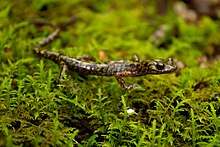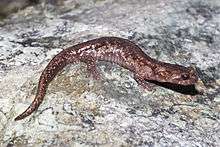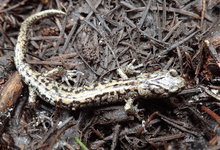Climbing salamander
Climbing salamanders is the common name for plethodontid (lungless) salamanders of the genus Aneides.[1] As this name suggests, most of these species have prehensile tails and are as mobile up a tree as in a stream.
| Climbing salamanders | |
|---|---|
 | |
| Aneides lugubris | |
| Scientific classification | |
| Kingdom: | Animalia |
| Phylum: | Chordata |
| Class: | Amphibia |
| Order: | Urodela |
| Family: | Plethodontidae |
| Subfamily: | Plethodontinae |
| Genus: | Aneides Baird, 1851 |
| Subgenera | |
| |
| Synonyms[1] | |
| |
Taxonomy
The green salamander (A. aeneus) and the Hickory Nut Gorge green salamander (A. caryaensis) are now considered to belong to their own subgenus Castaneides, which diverged from the Aneides hardii lineage between 27.2 and 32.3 million years ago, during the Oligocene. Castaneides contains significant cryptic diversity and may contain more as-of-yet undescribed species.[2] All other western Aneides including A. hardii are considered Aneides sensu stricto, and belong to the subgenus of the same name.[3]
Distribution
All ten known species in this genus inhabit mountain ecosystems in North America, and all but three are found primarily in the mountains of the west coast of the United States, Baja California and British Columbia. Of the three non-western species, the Sacramento Mountain salamander (A. hardii) is endemic to a mountainous region in New Mexico, while the two currently-described Castaneides species are endemic to the Appalachian Mountains of eastern United States.[2]
Species
Ten species in two subgenera are currently assigned to this genus:[1][3]
| Subgenus | Image | Binomial Name and Author | Common Name |
|---|---|---|---|
| Castaneides
(Patton et al., 2019) |
 | Aneides aeneus (Cope & Packard, 1881) | green salamander |
| Aneides caryaensis Patton et al., 2019[2] | Hickory Nut Gorge green salamander | ||
| Aneides
(Baird, 1851) |
 |
Aneides ferreus Cope, 1869 |
clouded salamander |
.jpg) |
Aneides flavipunctatus (Strauch, 1870) |
black salamander | |
.jpg) |
Aneides hardii (Taylor, 1941) |
Sacramento Mountain salamander | |
 |
Aneides iecanus (Cope, 1883) |
Shasta black salamander | |
.png) |
Aneides klamathensis Reilly & Wake, 2019 |
Klamath black salamander | |
 |
Aneides lugubris (Hallowell, 1849) |
arboreal salamander | |
 |
Aneides niger Myers & Maslin, 1948 |
Santa Cruz black salamander | |
 |
Aneides vagrans Wake & Jackman, 1999 |
wandering salamander |
Nota bene: A binomial authority in parentheses indicates that the species was originally described in a genus other than Aneides.
References
- Frost, Darrel R. (2017). "Aneides Baird, 1851". Amphibian Species of the World: an Online Reference. Version 6.0. American Museum of Natural History. Retrieved 10 July 2017.
- Patton, Austin; Apodaca, Joseph J.; Corser, Jeffrey D.; Wilson, Christopher R.; Williams, Lori A.; Cameron, Alan D.; Wake, David B. (December 2019). "A New Green Salamander in the Southern Appalachians: Evolutionary History of Aneides aeneus and Implications for Management and Conservation with the Description of a Cryptic Microendemic Species". Copeia. 107 (4): 748–763. doi:10.1643/CH-18-052. ISSN 0045-8511.
- "Plethodontidae". AmphibiaWeb. University of California, Berkeley. 2017. Retrieved 10 July 2017.
Further reading
- Baird SF (1851). Iconographic Encyclopædia of Science, Literature, and Art. Systematically Arranged by J. G. Heck. Translated from the German, with Additions, and Edited by Spencer F. Baird ... In Four Volumes. Vol II: Botany, Zoology, Anthropology, and Surgery. New York: Rudolph Garrique. xxiv + 203 (Botany) + 502 (Zoology) + 219 (Anthropology and Surgery) + xii + xvi + v (indices) pp. (Aneides, new genus, pp. 256–257 in Zoology).